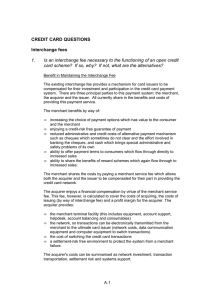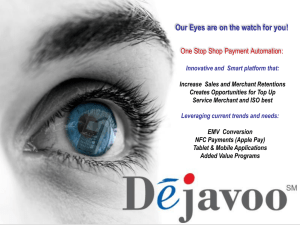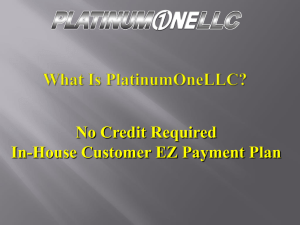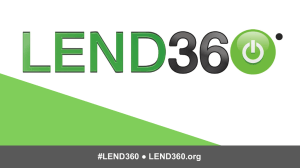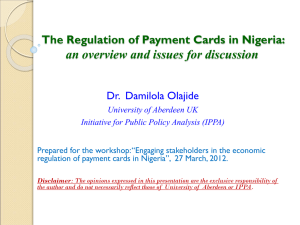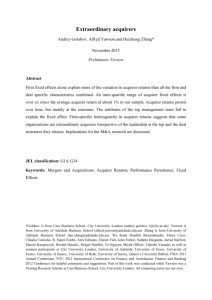Slides - Competition Policy International
advertisement
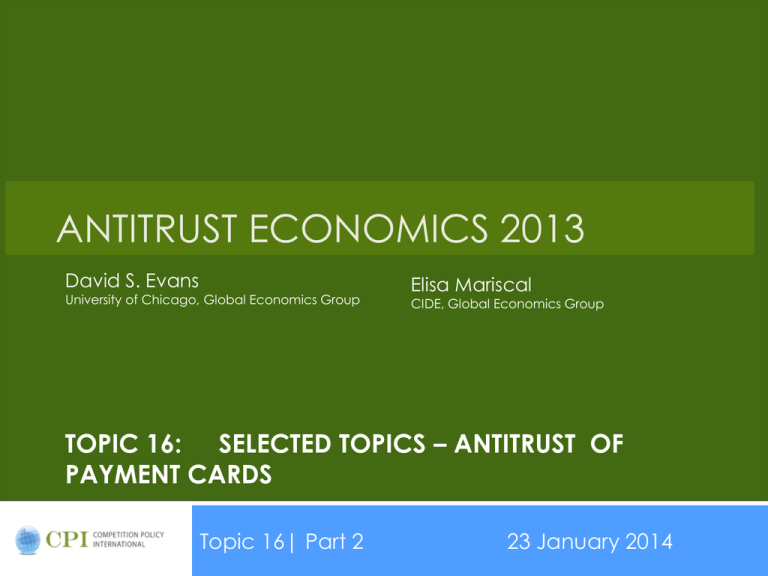
ANTITRUST ECONOMICS 2013 David S. Evans University of Chicago, Global Economics Group Elisa Mariscal CIDE, Global Economics Group TOPIC 16: SELECTED TOPICS – ANTITRUST OF PAYMENT CARDS Date Topic 16| Part 2 23 January 2014 Overview Topic 16 2 Part 1 Antitrust and Telecommunications Part 2 Currency Platforms Payment Cards Interchange Fees Merchant Rules 3 Currency Platforms Currency Platforms 4 Receiver of Funds Platform For payments to happen need to have underlying currency which is a unit of account, store of value, and medium of exchange. Senders and receivers both have to be on platform in the sense that they agree to the medium of exchange. Platform could be operated by government (euro), for profit (banks), customer (wampum), open source (bitcoin). Sender of Funds Critical Mass Problem for Payment Systems 5 All payment systems face demand coordination issue (“chicken and egg problem”). Senders will use a currency that receivers won’t take and receivers can’t be paid in a currency that senders don’t want to use. Governments can easily overcome the “chicken and egg” problem by paying with currency and making currency legal tender. But many currencies arise because they are able to secure critical mass of senders and receivers including airtime, bitcoins, wampum, and 19th Century American banknotes. Igniting New Payment Platforms: Bitcoin 6 Bitcoins issued in January 2009 Protocol invented November 2008 Bitcoin becomes widely used for “dark web” transactions and by drug lords Mainstream businesses start accepting bitcoin Bitcoin currency is a digital address. Bitcoin “miners” generate finite supply (21 million BTC) of bitcoins through solving hard math problems. Make money from selling currency they “mine” into the market. Public ledger of transactions where bitcoin transactions are posted. Exchanges convert bitcoins to other currencies but as more take sellers bitcoin less need to convert. 7 Payment Card Platforms 8 The Birth of the Modern Payment Card Industry Seeds for massive business planted in 1949 in Manhattan. Frank McNamara sees opportunity for “general purpose payment” card that many people could use to pay at many different merchants. Unlike “store cards” that were common at time, more like “cash” which could be used everywhere. Ignition: Diners’ Club 1950 9 Gives “charge” cards away to few hundred people to use to pay (free at use, pay bill at end of month). Signs up 13 restaurants to accept (10% of meal bill). Both consumers and merchants see value. Positive feedback effects drive growth. In 1951, a year after Diner’s Club launch, McNamara had signed up 330 restaurants, hotels and nightclubs, along with 42,000 cardholders. By 1956, almost $54 million of transactions (over $300 million in today’s dollars) on these cards at merchants from Boston to Anchorage to Tahiti. Lessons for Payment System Ignition 10 Innovation reduces “transaction costs” between merchants and consumers. Need both consumers and merchants to see enough value to launch. Solving this “chicken and egg” problem is essential. Hundreds of Diners Club competitors failed in 1950s. Getting critical mass of both sides can result in ignition and explosive growth. Hilton’s Carte Blanche sputtered, American Express ignited in 1958, as did Bank of America in 1958. First-mover advantage and positive feedback effects don’t guarantee permanent success: Diners Club eclipsed by American Express in 15 years. Discover Card bought Diners for $165 million in 2008. Three and “Four” Party Payment Card Systems 11 Three-party payment systems are “closed loop” platforms that provide payments services directly to merchants and consumers. American Express, Diners Club, Discover Card. “Four-party” payment systems separate the business of serving the merchant from the business of serving the consumer. MasterCard, Visa. Network provides B2B “open-loop” platform with “open entry” by issuers and acquirers. Card issuers connect with platform and serve consumers. Merchant acquirers connect with platform and serve merchants. Called “four party system” (issuer, consumer, acquirer, merchant) but really “five-party” system including the network which is key. Cooperative Model 12 Original “four-party” model was based on “consumer cooperative” where bank acquirers and issuers established and operated network. Banks became members and received voting rights. Appointed management. Cooperatives received transaction fees to fund operations including branding but otherwise operated on break-even basis. Partly (largely?) as a result of antitrust challenges to collective rule making MasterCard and Visa International adopted for-profit equity model in 2006 and 2008 respectively. Many four-party systems around the world (Visa Europe, and Carte Bleu, Multibanco operated as cooperatives still). The Structure of the Payment Card Ecosystem 13 • Own brand, recruit issuers and acquirers, authorize and settle. • Usually banks, issue cards to consumers, pay merchant’s agents (acquirers), collect money from consumer. • Often banks, sign up merchants, pay merchant when card is used, often pay issuer “interchange” fee required by network. Networks Issuers Acquirers/Processors Often called “4-party” or “open-loop” systems: (consumer |issuer | acquirer and merchant) like Visa Versus “3 party” or “closed-loop” systems (consumer | system | merchant) like Amex The Payment Card Industry in Spain 14 Issuers Networks Acquirers Banco Santader, Domestic and international schemes Banc Sabadell, Banesto, BBVA, Caja Madrid, Banco Santader, Bankia, Citibank, BBVA, Euro 6000, Comercia La Caixa Grupo Banco Popular MBNA Grupo Banco Popular, Unicaja The Payment Card Supply Chain 15 Merchant (Safeway) takes payment on card. Acquirer (First Data) sets up merchant and pays when card used. POS equipment (Ingenico) probably installed by acquirer takes cards at POS. Merchant processor (First Data) reads signal and switches transaction to network (might be same as acquirer) Network (MasterCard) uses card # to figure out which issuer and checks with issuer to make sure funds are available Bank Issuer (Citi) debits funds from checking account or includes charge of monthly credit-card statement Card Processor (TSYS) sends statement to consumer and collects money and sends to bank (bank issuer may do) Value-Added providers (PayPal) have solutions that rely on the rest of the chain. Integration into layers varies by country. Innovation is occurring at all of these layers and especially valueadded. The Payment Card Business Model 16 Merchant (Safeway) takes payment on card Acquirer (First Data) sets up merchant and pays when card used POS equipment (Ingenico) probably installed by acquirer takes cards at POS Merchant processor (First Data) reads signal and switches transaction to network (might be same as acquirer) Network (MasterCard) uses card # to figure out which issuer and checks with issuer to make sure funds are available Bank Issuer (Citi) debits funds from checking account or includes charge of monthly credit-card statement Card Processor (TSYS) sends statement to consumer and collects money and sends to bank (bank issuer may do) Network makes money from fees it charges acquirers and issuers Issuer makes money from “interchange fees” acquirers pay when cards are used plus fees and interest charges to consumers; bundled with checking account for debit Acquirer makes money from fees on top of interchange fees it charges merchants Merchant and card processors charge transaction fees Equipment manufacturers sell or lease equipment to acquirers or merchants Value-added providers charge additional fees or earn arbitrage fees 17 The Interchange Fee Controversy Merchant Pays Model for Cards 18 Ever since the beginning of the card industry (1950 in US) most of the costs for payment cards has been recovered from the merchant side so merchants are the money side and consumers are the subsidy side (see platform lectures). Consumers have highly elastic demand for payments in part because cash and check systems are subsidized by government. Consumers dictate choice of instrument at merchant. Merchants have relatively inelastic demand because they want to please customer and make a sale. Virtually every system, virtually everywhere in the world, has adopted the merchant pays model because of the fundamental two-sided economics of payments. 18 Interchange Fee 19 Interchange fee is a fee paid by one network side to the other network side. In payment card systems typically acquirer pays fee to issuer when issuer’s card is used to pay at acquirer’s merchant. Fees vary from a fraction of a percent to 4 percent across systems, countries, card products. Fee is typically set by the network sometimes unilaterally and sometimes by a process agreed to by the members of the network cooperative. Since the acquirer passes it on in whole or in part to the merchant and since the bank passes it on in whole or in part to the consumer it ultimately determines the relative prices faced by merchant and consumers just like merchant discount for threeparty system. Interchange Fees: Is There A Problem? 20 Multi-sided platform theory shows generally that platforms “may” not set socially optimal pricing balance. • Should we care since many businesses may not (probably do) set socially optimal prices and this is all blackboard economics anyway? Payment cards may result in a market failure because: • Consumer dictates choice but • Merchant bears cost • And because of either transactions costs, network rules, or both merchant can’t signal cost minimizing choice to consumer. • Results in consumers “overusing” cards versus other payment methods. Merchants and some commentators argue that interchange fee should be zero (on par) or small to cover costs. • Multi-sided platform literature is definitive on cost-based pricing being wrong. • How would we come up with the “right” price? These are all “problems” with merchant fees for three-party systems and not just interchange fees for four party systems. And Whose Problem Is It? 21 Antitrust Price fixing by cooperative members Need to establish efficiencies under US (BMI) or EU (Art 101(3)) EC and EGC in MasterCard Recent US settlement of Visa/MasterCard interchange fee litigation Banking regulators Is there a problem that regulators can deal with under existing banking regulation? Reserve Bank of Australia capped interchange fees based on finding market failure Legislature Is there an economic, social, or other problem that merit new laws? Generally economists limit business regulation to situations where there is a market failure that can be fixed. Durbin Amendment in US mandated costbased caps on debit interchange fees; proposed legislation before European Parliament. Antitrust Claims Against Interchange Fees 22 Note that merchant fee charged by three-party system in general are immune to antitrust challenge (except under excessive pricing theory) for the same reason companies no matter how dominant are allowed to charge whatever price they want. Antitrust case therefore based on “horizontal restraint” theory. In US could be per se in case but more likely rule of reason under for efficiency-creating cooperatives. In EU collective price setting could be ok under Article 101(3) exemption. But MasterCard since 2006 and Visa International since 2008 have been publicly traded corporations and not bank cooperatives. Two-Sided Antitrust Issues 23 Market definition: • One-sided acquirer market? • Two-sided platform market? Whose welfare? • Merchants as network customers? • Cardholders plus accepting merchants as network customers? • All consumers regardless of whether these use cards… What rate? • Acquirers and issuers have to agree on some fee even if zero so court or regulator needs to decide, but what? Net Impact on Consumers 24 Economics of pass-through shows when firms have increases in cost they pass part of it on to consumers and take part of it as reduced profit generally. Question is what fraction of cost increase is borne by consumers versus business. When banks lose revenue from caps they can make up from consumer (higher fees, reduced services) or by reducing profits. When merchants have lower costs they can pass some of savings on to consumers and keep some as profits. Net effect of price cap consumers therefore depends on how much they lose on bank side versus how much they gain on merchant side. Consumers overall “win” if bank pass-through rate is less than merchant pass-through rate and “lose” if merchant passthrough rate is lower than bank pass-through rate. Economics of Pass Through 25 Estimated pass through rates vary considerably and depend on market details including demand, cost, structure, behavior. Median pass-through from studies about 50 percent. Whose Welfare? Again 26 Suppose lower interchange fee results in net loss for consumers because banks pass on more of lost revenue than merchants pass on cost savings. Then acquirer market definition leads to result that merchants gain from interchange fee reduction but consumers overall lose. Two-sided market definition would consider both merchants and consumers as customers and evaluate overall impact of interchange fee on total price and overall output. Market Failure and Remedy 27 Court or regulator would need to determine the “right” fee. Theory says socially optimal fee likely to be smaller than privately set fee. But how much smaller? Cost-based test wrong as matter of two-sided market theory; prices do not necessarily (and probably do not) follow cost closely for socially optimal prices. Tourist test based on how much a merchant would be willing to pay to accept a card from a tourist who could also pay with cash. Not robust to merchant heterogeneity in costs and benefits. Full econometric estimation of two-sided prices based on cost and demand. Very difficult to do. Question is whether “regulator” can select a price that is better than “private actors”. Just as too high a price could be suboptimal so could too low a price. Could “collective merchant buying power” affected through collective lobbying for legislation or court ruling result in market failure of too low an interchange fee in which merchants profits to themselves by banks and cardholders? 28 Merchant Rule Controversy Platforms Harness Externalities 29 A Place to Get Together. • Platform provides a physical or virtual environment for different types of customers to get together. Ways to Connect and Create Value. • Platform provides search and matching methods for helping customers find “value-creating” transactions and for exchanging value. Manage externalities. • Platforms manage positive and negative externalities to increase value that members can realize from the platform. Platform Design and Rules Promote Positive Externalities 30 Sorting Devices to Get Right Customers: • “Exclusionary vibe” (JDate discourages Gentiles). • “Exclusionary amenity” (Upscale anchor stores discourages lowend shoppers). Search Diversion: • Design rules encourage one type of agent to meet another type of agent who really values them but may not seek out by themselves. • Shopping malls with anchor stores at either end. Platforms and Bad Behavior 31 Web Businessman Sentenced for Threats By DAVID SEGAL Published: September 6, 2012 A Brooklyn man who terrified customers of his online eyewear store with threats of violence, including rape, was sentenced on Thursday to four years in federal prison and ordered to pay nearly $100,000 in restitution and fines. Borker told the New York Times in 2010 that negative publicity had vaulted his site to the top of Google’s organic rankings. “I’ve exploited this opportunity because it works. No matter where they post their negative comments, it helps my return on investment,” he explained. “So I decided, why not use that negativity to my advantage?” Rule to Reduce Negative Externalities 32 Rules: • Prohibitions on actions that could harm other agents (usually those on other side of match/transaction). • eBay has detailed rules for buyer and seller behavior. No misleading ads (sellers) and no multiple auctions for same good (buyers). Detection and Monitoring: • Systems to determine if rules are being broken. • Facebook has hundreds of employees looking for bad pictures and bad language. Enforcement: • Platforms have and use “Bouncers Rights” to exclude violators. • Google manually reduces ranks of websites that violate rules for 90 days and sometimes delists websites. Welfare Effects of Rules 33 Promoting positive externalities has costs: • Sorting devices harm customers that can’t get on platform or don’t get their preferred matches. • Search diversion benefits side that gets from looks but not necessarily side that has been diverted. Governing bad behavior has costs: • Customers lose benefits from violations. • Customers also lose from false positives in enforcement. Platform has incentives to balance benefits and costs: • Platform can make more money by promoting positive externalities and reducing negative ones. • Platform value is greater and platform profit greater too. Vertical Restraints and Platform Governance 34 Anti-steering/exclusive dealing rules: • Might deter entry, but… • Give customers on other side assurance that when they use the platform they will get the platform’s products. No surcharge rules: • Might deter entry, but … • Prevents opportunistic behavior and provides customers price certainty for platform. Platform exclusion penalties and rules: • Might prevent alternative platform from accessing users, but … • Punishes customers on one side from harming customers on the other side through fraud, deception, and other bad behavior. End of Topic 16, End of the Antitrust Economics Course 35 Part 1 Antitrust and Telecommunications Part 2 Currency Platforms Payment Cards Interchange Fees Merchant Rules


